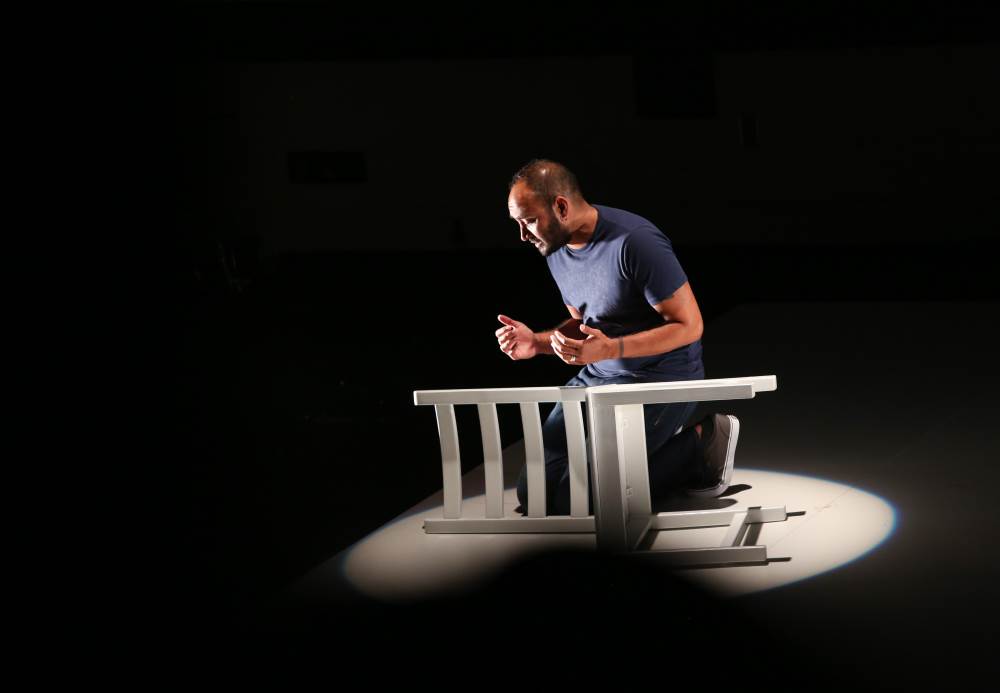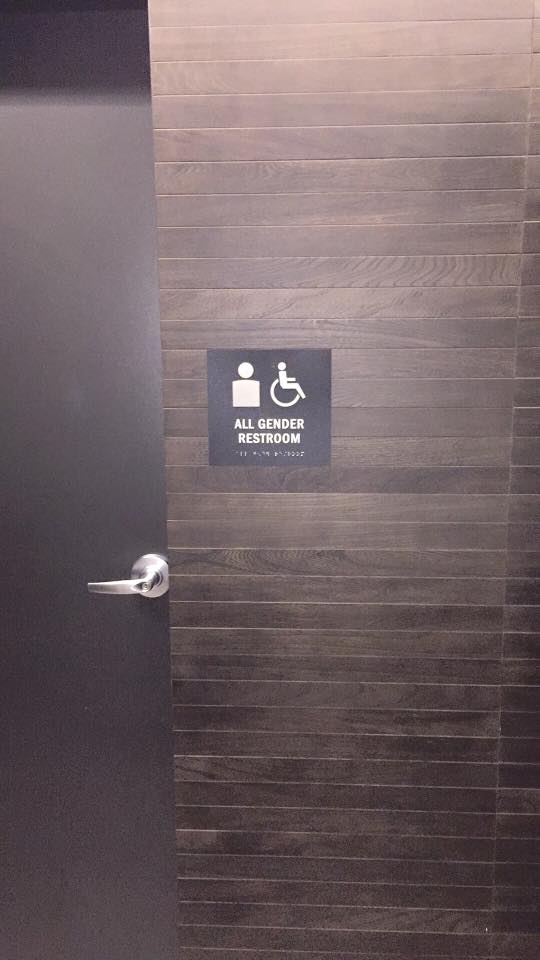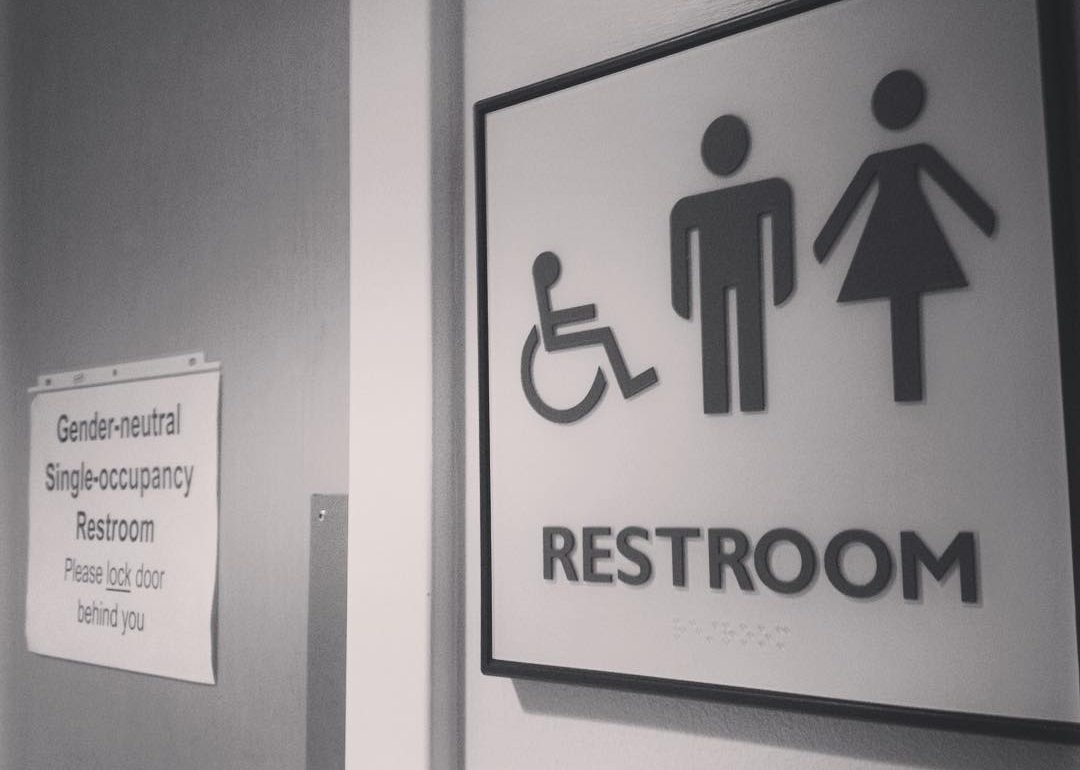For as long as the selfie has been an ubiquitous means of self-expression, a common variation of the selfie has been the bathroom-mirror selfie, popularized by online daters, Instagramers, and Kim Kardashian. But in response to North Carolina’s House Bill 2, which said in part that transgender individuals would be required to use bathrooms that matched the gender on their birth certificate (among other attacks on the state’s LGBTQ population), artist Mashuq Mushtaq Deen decided to take bathroom selfies to a whole new level.
Deen is trans and identifies as a man, and usually uses the men’s bathroom. But HB2 mandates that he use the women’s restroom. So while Deen was presenting his one-person play Draw the Circle at PlayMakers Repertory Company in Chapel Hill, N.C., in late August, he decided to go into the women’s restrooms, interview the women in there, and take selfies with them (with their permission). He’s been posting the results on his Facebook page.
In one interview, Deen asked a woman if she’s ever used the men’s room. The woman’s response: “I have been in a men’s restroom. A lot of times during the intermission of a show I was working, the women’s line would be so backed up but the men’s almost empty…A few times I have had people glare at me or remind me that I was in the wrong one.”
Deen’s photo series was intended to illustrate the absurdity of the law. “I know I can use the men’s room if I want to and no one’s gonna ask me any questions,” he said. Taking pictures of himself in a place he clearly doesn’t feel he belongs, he thought, “would be a good way to draw attention to [HB2], because I know there’s a lot of people who feel like they don’t really have the choice.” He added for emphasis: “I am following the letter of the law.”
It was also a way to highlight the ridiculousness of the current national conversation. Not since the musical Urinetown have people questioned where their fellow citizens have the “privilege to pee.” Mississippi and North Carolina have made headlines for their discriminatory legislation on this matter, and 18 states have introduced bills that would similarly regulate bathroom access.
But last month U.S. District Judge Thomas Schroeder blocked public schools from enforcing HB2. And in May, the Obama administration issued a directive to public schools saying that the institutions should allow trans students to use the bathrooms that match their gender identity, and will withhold federal funding for non-compliance. These are but small rays of hope: So far 21 states have sued the administration for its directive. Considering the sheer number of lawsuits and legislation, this bathroom battle may reach the Supreme Court.
In response to these discriminatory laws, though, theatres are taking some practical steps. Because PlayMakers Rep, housed on the campus of University of North Carolina-Chapel Hill, is part of a public institution, they must comply with HB2 (private institutions are exempt). But that didn’t stop PlayMakers’ artistic director Vivienne Benesch from taking the issue up with the dean of the College of Arts and Sciences. Under HB2, she was not allowed to convert any multi-stall bathrooms to serve all genders, but she could make single-stall bathrooms all-gender. So beginning with their presentation of Draw the Circle, the hallway bathrooms at PlayMakers were converted from multi-stall into single-stall facilities with all-gender signs on them. Though the main bathrooms in the lobby are still separated by gender (which is where Deen took his selfies), Benesch sees this as a small but important step.
“I don’t even necessarily see it as protesting [HB2] as much as an affirmation of what we do stand for,” she said. “To have a professional theatre company within an educational state research university, we have an opportunity of speaking directly to inclusivity. So is it a protest via affirmation, yes.”

A few weeks ago I was in the lobby of St. Ann’s Warehouse in Brooklyn. Taylor Mac’s show A 24-Decade History of Popular Music was about to start and I had to wash my hands. St. Ann’s Warehouse recently moved into a former red-brick space next to the East River, beneath the Brooklyn Bridge. As part of the redesign, St. Ann’s created a novel bathroom configuration. While there are separate doors with male and female insignias on them, either one leads to the same large room with stalls on either side for all gender identities. The sinks are in a communal washing area.
That night, out of laziness, I decided to enter via the men’s door (the female door was on the far side). As I exited via that same door, a male patron looked at me in confusion as he entered (I’m a cisgender woman and was wearing a dress with a full skirt). I recounted that to Ty Defoe, a trans artist and a facilitator for Art Equity.
“Yes!” he exclaimed. “I also love that St. Ann’s does that. Such a mindfuckery of labels.” He sums up the current conversation about bathrooms very simply: “In your home, do you use a gendered restroom?”
The common pretext given by supporters of bills such as HB2 is that they’re needed to protect women and young girls from male predators masquerading as women (an unfounded claim that has been thoroughly debunked). St. Ann’s artistic director Susan Feldman find such attitudes disingenuous. “There are situations where men prey on men,” she said. “They prey on boys. It’s not just about gender. We can’t bar men from going to the bathroom.”
Instead, she thinks the fear about bathrooms is rooted in something older. The gendered bathrooms are “really an old idea that came out of Puritanism,” she said. “If men and women were together, something terrible would happen. I think that’s been gone for so long, since they made dorms co-ed.”
St. Ann’s is not the only institution freeing their bathrooms from the binary. The Public Theater in Manhattan has created single-gender stalls (there are also signs outside of the gendered multi-stall bathrooms that read, “Gender diversity is welcomed here; please use the restroom that best fits your gender identity or expression”).
At the recent TCG National Conference in Washington, D.C., the multi-stall bathrooms were made all gender. As an attendee I witnessed the rare but delightful sight of men waiting in line for the bathroom (one male conferencegoer even said he’s never been in that situation). The transition wasn’t entirely without wrinkles—some female attendees expressed discomfort with male urinals in the formerly men-only bathrooms, and with losing a formerly all-female “sanctuary.” But as disconcerting as it may be for cisgender men and women to see members of the opposite sex entering the same bathroom door, once inside the stall we should surely be able to focus on the business we’re there for.

Writers Theatre’s new building in Chicago has private stalls that aren’t gender-specific, as well as gender-specific multi-stall facilities. The question about signage was discussed in detail.
“We felt that an ‘All Gender’ bathroom [sign] was the most inclusive of all of the options presented to us for the single dedicated stall,” explained artistic director Michael Halberstam. “‘Family Bathroom’ felt too specific, for instance, and almost more exclusive than inclusive, and ‘Gender Neutral’ is not a term preferred by the LGBTQ community.”
These facilities are also becoming a common sight at colleges and universities, which reflects popular opinion; according to a recent study from the Public Religion Research Institute, 53 percent of Americans oppose laws that require trans individuals use the bathrooms that matches the gender on their birth certificate; 35 percent favor those laws.
While politicians like North Carolina Gov. Pat McCrory say they fear trans individuals assaulting cisgender women, in fact it’s trans people who are most at risk. Deen said he was harassed “all the time” when he was still transitioning and using the women’s restroom. “They’d either snicker or you go into the stall and they’d be like, ‘What is that? That is in the wrong bathroom, what is it?’” he said. “It’s hard to defend yourself when your pants are around your ankles; it’s a vulnerable place to be.”
Deen’s anxiety about going into public restrooms isn’t an anomaly. According to a 2015 article in The New York Times, “Many transgender people report planning their days around where and when they can go, enduring bladder infections if they hold it in, risking harassment or violence if they don’t.” A study from the Williams Institute at the University of California-Los Angeles found that out of 93 trans and gender-nonconforming people in Washington, D.C., 70 percent reported being harassed while using a public restroom; eight reported being physically attacked.
So for trans individuals, an inclusive bathroom sign is a marker of something bigger. “All-gender restrooms are an intricate symbol of where LGBTQT+ look for signs of acceptance at an institution,” said Defoe. “These are indicators that read, ‘You are seen and welcomed here.’”
While the American theatre is currently grappling with how to make itself more diverse and inclusive, changing a bathroom sign can be a small but important step in that process. In a time when a lesbian is forced to leave a woman’s restroom because the police believe she’s a man, a toilet is no longer just a toilet. It’s a place where theatres can take a stand for equality, for both artists and audiences.
For any institution thinking of changing all of their bathrooms, multi-stall and single stall, to all-gender, Deen believes that good communication to the entire patron base is key.
“I think we make enemies of people when we say, ‘Now you have to change your way of life and we’re not even going to bother to take the time to explain why to you,’” he said. “But to say, ‘Look, this is really meaningful for me because this is what it feels like when I go into a bathroom.’ I think people want to be on your side when they’re let in to understand why that is important to you.”


